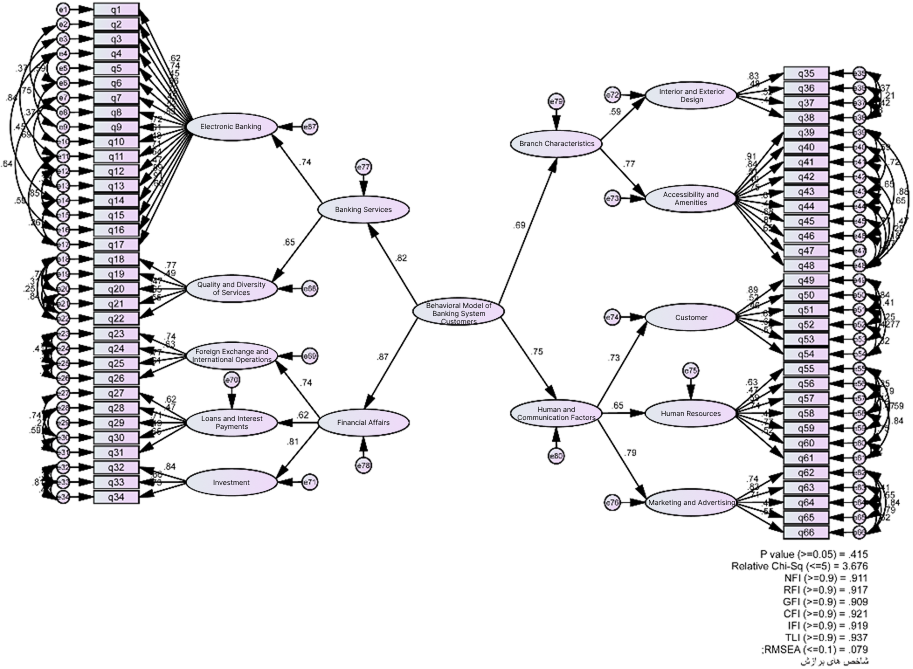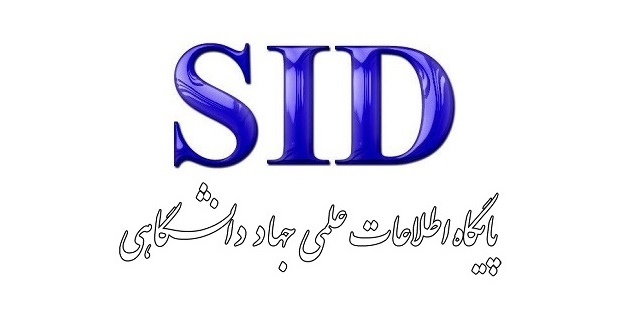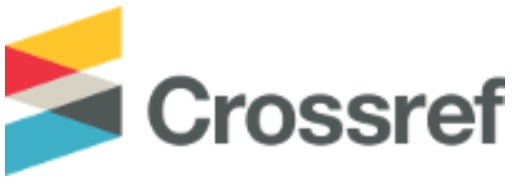Designing and Validating a Behavioral Model of Banking System Customers
Keywords:
banking services, financial affairs, branch characteristics, human and communication factors, customer behavioral models in the banking systemAbstract
The aim of the present study is to design and validate a behavioral model of banking system customers. The research method is a sequential exploratory mixed-methods approach. In the qualitative section, research participants included university professors in fields related to marketing management and business, as well as heads, deputies, and customer relations managers in Bank Day branches in Tehran, totaling 12 individuals selected through purposive (snowball) sampling based on the principle of theoretical saturation. The data collection tool consisted of semi-structured interviews, and the validity and reliability of the tool were evaluated based on the method proposed by Lincoln and Guba. Data analysis was conducted using thematic analysis (Attride-Stirling method) with MAXQDA 2020 software. In the quantitative section, the research method was descriptive-survey, and the statistical population consisted of Bank Day customers in Tehran. Due to the unlimited population, 410 individuals were selected as the statistical sample using Cochran's formula and stratified random sampling. The data collection tool in this section was a researcher-made questionnaire derived from expert opinions in the qualitative section. To assess the validity of the research tool, construct validity was measured using the Kaiser-Meyer-Olkin (KMO) measure of sampling adequacy and Bartlett's test of sphericity, while reliability was assessed using Cronbach’s alpha coefficient and composite reliability. Quantitative data were analyzed using descriptive statistics (mean and standard deviation) and inferential statistics with SPSS 22 and SMART PLS 3 software. The results of the qualitative data analysis led to the identification of four overarching themes (banking services, financial affairs, branch characteristics, and human and communication factors) in the form of ten organizing themes (electronic banking, quality and diversity of banking services, foreign exchange and international operations, banking loans and interest payments, investment, internal and external branch design, branch accessibility and welfare facilities, customers, human resources, marketing and advertising) and 66 basic themes. Ultimately, the findings from the quantitative data analysis indicated that the designed model possesses desirable fit and validity.
References
R. Yahaya, O. A. Abisoye, and S. A. Bashir, "An Enhanced Bank Customers Churn Prediction Model Using A Hybrid Genetic Algorithm And K-Means Filter And Artificial Neural Network," pp. 52-58, 2021. [Online]. Available: https://doi.org/10.1109/CYBERNIGERIA51635.2021.9428805.
C. Homburg, K. Lauer, and A. Vomberg, "The multichannel pricing dilemma: Do consumers accept higher offline than online prices?," International Journal of Research in Marketing, vol. 36, no. 4, pp. 597-612, 2019. [Online]. Available: https://doi.org/10.1016/j.ijresmar.2019.01.006.
I. Malek Akhlaq, Y. Mohammadi Karimi, and D. Talebi, "Designing a model of banking customer behavior in online social media," Business Management Explorations, vol. 13, no. 25, pp. 475-497, 2021.
O. Dubina, Y. Us, T. Pimonenko, and O. Lyulyov, "Customer loyalty to bank services: The bibliometric analysis," Virtual Economics, vol. 3, no. 3, pp. 53-66, 2020. [Online]. Available: https://doi.org/10.34021/ve.2020.03.03(3).
G. Alfian, M. F. Ijaz, M. Syafrudin, M. A. Syaekhoni, N. L. Fitriyani, and J. Rhee, "Customer behavior analysis using real-time data processing: A case study of digital signage-based online stores," Asia Pacific Journal of Marketing and Logistics, 2019. [Online]. Available: https://doi.org/10.1108/APJML-03-2018-0088.
P. A. Sarvari, A. Ustundag, and H. Takci, "Performance evaluation of different customer segmentation approaches based on RFM and demographics analysis," Kybernetes, 2016. [Online]. Available: https://doi.org/10.1108/K-07-2015-0180.
S. C. Ho, K. C. Wong, Y. K. Yau, and C. K. Yip, "A machine learning approach for predicting bank customer behavior in the banking industry," in In Machine Learning and Cognitive Science Applications in Cyber Security, 2019: IGI Global, pp. 57-83. [Online]. Available: https://doi.org/10.4018/978-1-5225-8100-0.ch002.
L. Calzada-Infante, M. Óskarsdóttir, and B. Baesens, "Evaluation of customer behavior with temporal centrality metrics for churn prediction of prepaid contracts," Expert Systems with Applications, vol. 160, p. 113553, 2020. [Online]. Available: https://doi.org/10.1016/j.eswa.2020.113553.
A. Amin, F. Al-Obeidat, B. Shah, A. Adnan, J. Loo, and S. Anwar, "Customer churn prediction in telecommunication industry using data certainty," Journal of Business Research, vol. 94, pp. 290-301, 2019. [Online]. Available: https://doi.org/10.1016/j.jbusres.2018.03.003.
S. Khodabandehlou and M. Z. Rahman, "Comparison of supervised machine learning techniques for customer churn prediction based on analysis of customer behavior," Journal of Systems and Information Technology, 2017. [Online]. Available: https://doi.org/10.1108/JSIT-10-2016-0061.
J. A. Bakar and A. A. Adzis, "Fostering loyalty among young consumers: Strategic approaches for bank sustainability," International Journal of Professional Business Review, vol. 9, no. 3, p. e04469, 2024. [Online]. Available: https://doi.org/10.26668/businessreview/2024.v9i3.4469.
R. Saral, R. Salehzadeh, and S. M. Mirmehdi, "Investigating the influence of service quality on loyalty in banking industry: the role of customer engagement," International Journal of Services, Economics and Management, vol. 15, no. 1, pp. 1-18, 2024. [Online]. Available: https://doi.org/10.1504/IJSEM.2024.136057.
M. I. M. Riyath, "Causal Factors of Customer Loyalty in Sri Lankan Banks," 2024. [Online]. Available: https://doi.org/10.4038/sljmuok.v9i3.154.
R. Y. S. Ringo, D. Septyanto, and A. H. Ramli, "Analysis of Factors Affecting Customer Satisfaction and Customer Loyalty in the Shopee Marketplace," Majalah Ilmiah Bijak, vol. 20, no. 2, pp. 293-310, 2023. [Online]. Available: https://doi.org/10.31334/bijak.v20i2.3427.
I. Maulana, Y. Z. Basri, and T. Mariyati, "Factors Affecting the Customer Loyalty of Sharia Rural Bank," Amwaluna: Jurnal Ekonomi dan Keuangan Syariah, vol. 6, no. 2, pp. 340-361, 2022. [Online]. Available: https://doi.org/10.29313/amwaluna.v6i2.10038.
A. Kalinin, D. Vaganov, and K. Bochenina, "Discovering patterns of customer financial behavior using social media data," Social Network Analysis and Mining, vol. 10, no. 1, p. 77, 2020. [Online]. Available: https://doi.org/10.1007/s13278-020-00690-3.
F. Pourvahidi, S. A. Abolfazli, M. Rezvani, and N. Mirsapasi, "Designing a model of factors affecting customer citizenship behavior and its consequences in customers of foreign home appliance products," Business Management Outlook, vol. 49, pp. 95-123, 2022.
A. A. Arsenjani, "Designing a model for electronic banking business in Iran," Doctoral dissertation, Islamic Azad University, Rasht Branch, 2020.
M. Rezvani, M. Rezaei, and K. Tanha Pour, "A customer loyalty model in emerging organizations based on artificial neural networks: A case study of emerging private banks," Modern Marketing Research, vol. 10, no. 1, pp. 63-82, 2020.
M. Mehrabpour, "Investigating the impact of cognitive and emotional evaluations of customers on their altruistic behaviors in the banking industry using thematic analysis," Doctoral dissertation, Islamic Azad University, Kermanshah Branch, 2018.












